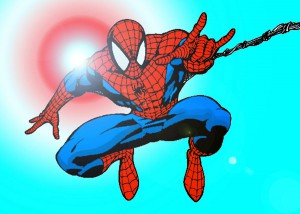By Claire Donnelly
What if instead of evading the evil Dr. Octopus by scaling the nearest wall, Spider-Man found himself stuck to every object he passed?
According to some scientific researchers, that’s exactly what would happen if Spider-Man’s sticky pads were correctly proportioned to his body weight.
In a study published in the January issue of the Proceedings of the National Academy of Sciences, researchers in the U.S., U.K. and Australia examined how certain physical features–specifically, sticky pads–change as an animal’s body size changes. The study of these changes is known as allometry.
For David Labonte, lead author of the study, that meant looking at a lot of gecko feet.
Labonte, a researcher in the Department of Zoology at the University of Cambridge, and his team collected data for 225 different climbing animals across classes, including amphibians, arachnids, insects, mammals and reptiles.
Labonte said studying the way climbing animals like geckos use adhesive pads could help researchers working to develop bio-inspired adhesives, or man-made adhesives that work like gecko or insect feet.
Looking at how animals change their sticky pad size as they grow could present potential solutions for how to make these adhesives stronger and more effective.
Daniel Boehm, zoological manager at the Lincoln Park Zoo, explained that many gecko species (there are over 900 different ones) are able to stick to walls thanks to small, hair-like projections on their sticky toe pads.
“[It’s] a very, very remarkable adaptation,” he said. “[It] creates incredible biomechanical adhesion.”

Boehm has worked with different gecko species, including gold-dust day geckos and leaf-tailed geckos, though he said the zoo’s current collection has only one species that uses adhesive toe pads–the Standing’s day gecko (Phelsuma standingi).
For the study, Labonte and his research team photographed larger animals’ adhesive pads using a camera mounted on a microscope or scanned them digitally using a photo scanner. The team capture images of smaller animals’ pads using a scanning electron microscope, which scans samples with a focused beam of electrons.
To collect data on the animals’ mass, researchers either weighed the living animals or calculated the weight based on the animals’ length using established criteria.
The study results showed “extreme positive allometry.” That means the surface area required to be covered with sticky pads increases with animal size, or a gecko’s sticky pads get bigger as the gecko grows larger.
“If we look across all these animals, then we find that the area of the pads changes in direct proportion to the body weight,” Labonte said. “That means that larger and larger animals have to use a larger and larger fraction of the surface area as adhesive pads.”
A gecko, for example, requires a greater percentage of its surface area to be covered with sticky pads than a small mite. According to the study, the fraction of the gecko’s surface area that needs to be sticky is 200 times larger than the mite’s.
So are there limits to how big an animal can be that uses sticky pads?
Labonte said his data indicate a size limit for animals with sticky pads but he and his team were unable to give a precise numerical value for that limit.
“You can only do it to a certain size,” he said. “What exactly that size is and whether there are other factors that also determine the size, we don’t know.”
And this is where Spider-Man comes in. Labonte and his fellow researchers extrapolated their study results to address the scientific plausibility of everyone’s favorite web-slinging superhero.

Assuming that Spider-Man would follow the patterns observed in the animal study, the researchers suggested that Spider-Man would need to have two-fifths of his available body surface area covered with sticky pads to be able to support his weight while climbing walls, Labonte said.
And since sticky pads are only helpful if they’re on the front of Spider-Man’s body rather than on his back, 80 percent of his front surface area would need to be sticky.
“It’s fairly impractical,” Labonte said. “I’m not sure whether he would be able to actually hunt any villains or anything.”
Mark Bagley, a comic book artist who has worked for Marvel Comics on such titles as The Amazing Spider-Man and Ultimate Spider-Man, said he’s not concerned about the impact of this study on the comic book industry.
“It’s just comics,” Bagley said. “[Spider-Man] has spider powers … It’s imagination. It’s fantasy.”
Bagley has penciled hundreds of comic books since the late 1980s, and the comic community reveres his work. Bagley said he didn’t anticipate any fan backlash from Spider-Man’s lack of scientific feasibility.
“I don’t think fans will be disappointed,” Bagley laughed. “I think 99.99 percent [of them] are relatively grounded in the real world.”
Spider-Man’s stunts are safe within the pages of comic books, but don’t try climbing a wall in your Halloween costume–you’ll need a lot of sticky pads.


